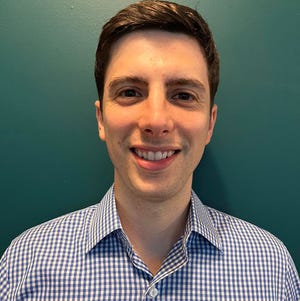The AI Future of Finance Is NowThe AI Future of Finance Is Now
Portrait Analytics exits stealth with $3 million in seed funding and generative AI that is emblematic of what the future holds for advisors.

Over the last three weeks I’ve received dozens of pitches about ChatGPT and generative AI, mainly from PR folks working for “experts” offering to comment on stories.
Far more interesting among those pitches has been the handful of messages from founders of new generative AI startups focused on financial services who had read something I’d written and thought I might like to hear more.
One of those came from David Plon, the co-founder and CEO of Portrait Analytics, a generative AI research platform for investment analysts, which was founded in 2022 but exited stealth on Thursday with the announcement of $3 million in pre-seed funding. The financing was led by .406 Ventures with participation from a few hedge funds.
“Ultimately, the vision I have is, essentially, to build an AI-powered junior analyst,” said Plon.
In other words, Portrait is being built so it can answer any question or perform the tasks typically asked of a junior analyst at a hedge fund today. This can include having the analyst suggest ideas, build financial models or create pitch decks and author memos.
“The way I think about it, is that I know the analyst workflow really well,” he said, having spent almost five years as an analyst at The Baupost Group in Boston. And that workflow and its processes and the required datasets is where his small team of developers and engineers have focused.
The human version of these analysts spend untold hours per year pouring over thousands of documents to research companies and stay current on their coverage area.
Plon explained that Portrait’s first product is a question-and-answer-based application that has both generative AI search and “summarization.” Or, as the company states, “Portrait responds to users’ tasks by extracting and synthesizing key information buried in company filings to produce crisp and factual responses that are fully auditable by users.”
“Down the road we hope and envision creating something that anyone involved in investing can use—I’d love, if in five years, that my mother’s own financial advisor had access and used this on a daily basis,” said Plon.

David Plon
But it’s not amassing and incorporating all the necessary data to power Portrait that is Plon’s biggest expense.
“The biggest cost is the engineering time required to create a system that is both useful and reliable,” said Plon.
Building the startup’s ever-growing repository of data and knowledge graph, while challenging, pales compared to the engineering challenges of creating its language model, he said.
As for data, it will vary greatly from EDGAR (the SEC’s Electronic Data Gathering, Analysis, and Retrieval system), which is free and publicly available, to earnings call transcripts and other data that may not be publicly searchable but is available, and ultimately, to piping in user data.
While the platform is in private beta, with plans to release access to analysts on its waiting list in the coming months, Portrait is just the latest in a string of generative AI products for advisors or with advisors on their roadmap.
Jan Szilagyi, CEO and co-founder of Toggle, created a cloud-based AI application with its own machine learning and natural language processing algorithms that were built in-house and looks at millions of pieces of data for its users and comes back with thousands of points of interest, called Toggle Insights, each day.
I wrote about Toggle, which shares many similarities (at least from the outside looking in) with Portrait, back in August. It already has a far wider and more varied user base that includes hedge funds, banks and professional investors. It also has a wait list for its own generative experience, expected in the next few months.
Szilagyi’s team is currently at work “teaching ChatGPT how to invest—not hallucinate … [giving it] a crash course in finance,” as it states on Toggle’s homepage.
“The exciting frontier we are at now—and it is unbelievably exciting—is that we are able to have two-way communication, you’ll be able to ask follow-up questions,” said Szilagyi, referring to the addition of generative AI with its language models to the already built and working ML and NLP technology under Toggle’s hood.
He said advisors can ask the system, for example, about impacts on a client portfolio if the yield curve inverts and immediately get a response back along the lines of: “Here are the most vulnerable parts of your portfolio.”
“You can then respond with another what if, you’ll be able to control it simply by being able to articulate the question—it will provide an unparalleled ability to take the English language and convert it into computer code,” said Szilagyi, adding that it was akin to having a digital Rosetta Stone and being able to not just read or translate hieroglyphics but in turn write them as well.
Adnan Masood, PhD, who heads up the AI and Machine Learning group at global technology consultancy UST, said he has been struck by the recent massive public and media reaction to what have appeared to be instantaneous breakthroughs in generative AI, starting with ChatGPT.
“Those of us that are researchers in the field are not surprised, we have seen the painstaking evolution,” he said, noting that while what ChatGPT does can seem almost to be like magic, it has taken prodigious research to get there.
And while the focus here is with financial services, Masood detailed other available or near-term developments where generative AI is already making or will make tremendous impacts, from health care to cybersecurity.
He said specific use cases include understanding customer sentiment at scale by combining ML, NLP and generative AI to analyze customer service call logs and reduce fraudulent insurance claims through combining the technologies and analyzing claims data.
Another use case in financial services was in the lending industry where tedious and traditionally human-based loan decisioning occurs.
“Banks are looking at quantitative data but the textual unstructured qualitative data in terms of say, business plans, was not something that could previously be brought in in any scalable way,” said Masood. “Now you can bring not only that sort of information but ingest local market conditions in the decisioning process.”
In addition to the low-hanging fruit of content generation, advisors are likely to see some early useful advancements when it comes to compliance automation.
For example, applications that will ingest trading notes, something that has been a perfect use case for NLP over the last few years.
“Now with generative AI you can start to analyze good notes and bad notes in real time and ask the system to determine whether this note would pass an audit or not?” said Masood.
While the potential in AI, and generative AI in particular, is certainly awe-inspiring, Masood cautions that identifying risk and biases in the language models presents a challenge, not an insurmountable one, but one that perhaps many in awe of AI are not yet familiar enough with.
He also noted the recent exposure of ChatGPT user personal information and chat titles due to an internal bug that came to light recently.
“Imagine that happening to a large financial services organization, there needs to be layered security and guardrails in place,” he said.
About the Author
You May Also Like







